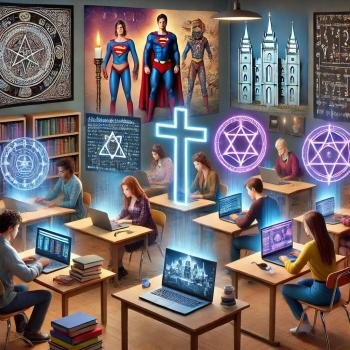
Faith in the Digital Age: Ensuring Accuracy in Emerging Media
In today’s world, we are witnessing a digital revolution that is touching every corner of our lives—how we learn, how we connect, how we express ourselves. Artificial intelligence, immersive gaming, and digital storytelling platforms are not just reshaping entertainment or business; they are reshaping how we experience culture, spirituality, and community. Faith, once confined to physical spaces like mosques, churches, temples, and synagogues, is now finding its way into the fabric of the digital world.
From AI-generated sermons to virtual prayer rooms, faith-based gaming to augmented reality pilgrimages, spiritual themes are entering these new spaces at a breathtaking pace. And while this presents incredible opportunities, it also brings serious risks—particularly when it comes to accuracy, respect, and authentic representation.
If we want the next generation to encounter faith online in a way that nurtures understanding rather than distorting it, we must act now. Faith leaders, media professionals, educators, and tech innovators all have a role to play. It is not enough for faith to simply be present in digital spaces—it must be represented with care, depth, and truth.
Accuracy in AI: Stewarding Sacred Knowledge
Artificial intelligence is now writing articles, answering religious questions, and even generating sermons.
But AI doesn’t inherently know sacredness. It doesn’t intuit nuance. It doesn’t understand that a verse from scripture carries centuries of scholarship, cultural context, and lived human experience.
This is where faith leaders and media professionals must step in. We must advocate for partnerships between tech companies and authentic scholars across diverse traditions.
We must call for advisory boards—composed not just of engineers, but of theologians, ethicists, and community leaders—who can guide how AI handles sacred texts and spiritual topics.
We need AI models that are trained not only on vast data, but on reverence for what they carry.
Accuracy isn’t a luxury when it comes to faith—it is a responsibility.
Games That Get It Right: Shaping the Next Generation’s Imagination
In the world of immersive gaming and interactive storytelling, faith themes are often sprinkled in—but without the care they deserve.
Too often, we see stereotypes reinforced, traditions trivialized, or sacred symbols used carelessly as exotic “props.”
Problematic Games: Laced with Stereotypes and Misrepresentation

Muslim Massacre (2008) is a stark example. This amateur game, subtitled The Game of Modern Religious Genocide, tasked players with killing as many Muslims as possible, including civilians and religious figures. The game’s creator claimed it was satirical, but it was widely condemned as Islamophobic and inciting violence against Muslims.
Mainstream titles have also perpetuated harmful stereotypes. The Call of Duty franchise has faced criticism for depicting Middle Eastern characters predominantly as terrorists, reinforcing the narrative that Arabs and Muslims are inherently violent.
Similarly, IS Defense (2016) places players in the role of a NATO gunner defending Europe from an invading Islamic State force. While aiming to portray a fictional scenario, the game has been criticized for its simplistic portrayal of Muslims as aggressors, lacking nuance and contributing to Islamophobic sentiments.
These portrayals not only misrepresent the diversity and richness of Muslim cultures but also contribute to real-world harmful prejudice and misunderstanding.
The Solution: Authentic and Respectful Representation
However, the gaming industry is beginning to recognize the importance of accurate and respectful representation. Assassin’s Creed Mirage (2023) by Ubisoft is a notable example. Set in 9th-century Baghdad, the game immerses players in the Islamic Golden Age, portraying Muslim characters with depth and authenticity. The developers consulted historians and cultural experts to ensure accurate depictions of the era’s architecture, language, and societal norms.
Indie games are also making strides. Titles like 1979 Revolution: Black Friday offer nuanced narratives that explore the complexities of political and religious identities in Muslim-majority countries, moving beyond one-dimensional portrayals.
Moving Forward: Collaboration and Cultural Sensitivity
To foster a more inclusive gaming landscape, collaboration between developers and Muslim communities is essential. This includes:
- Consulting Cultural Experts: Engaging scholars and community leaders to provide insights into Islamic traditions and cultures.
- Diverse Development Teams: Encouraging diversity within game development teams to bring varied perspectives and experiences.
- Community Feedback: Actively seeking feedback from Muslim gamers to understand their perspectives and experiences.
By embracing these practices, the gaming industry can move toward more accurate and respectful representations, enriching the gaming experience for all players.
Yet there are bright spots. Games like Journey offer a subtle, almost spiritual experience without reducing any one tradition. Faith-based games like That Dragon, Cancer explore grief, prayer, and hope with heartbreaking honesty. These examples show that it can be done—and done beautifully.
We need more creators who engage faith traditions not for sensationalism, but for storytelling that honors the human yearning for meaning.
Developers must consult with faith communities, embed research into their creative processes, and recognize that getting it right isn’t just about “accuracy”—it’s about building empathy and belonging.
Virtual Spaces, Real Belief: Nurturing Digital Worship
The pandemic accelerated the rise of virtual faith spaces—mosques live-streaming Jumu’ah prayers, churches hosting worship in Virtual Reality, Buddhist sanghas gathering on Zoom, and synagogues holding virtual Shabbat services.
While virtual spaces will never fully replace the power of being together in the same room, engaging in social interactions, they are real spaces of belief, hope, and healing for millions.
And they are here to stay.
If so, we must ask:
Are these digital faith communities being designed with the richness of real-world practices in mind?
Are they accessible, inclusive, and reflective of the deep diversity within religious traditions? Do they elevate the human factor?
It is not enough to merely “stream” worship services. We must think deeply about how the sacred is translated into digital architectures, about how rituals adapt when mediated through screens, and about how to maintain authenticity even in pixels.
Interfaith Potential vs. Digital Silos: Bridging, Not Dividing
One of the most beautiful potentials of digital media is the ability to foster interfaith engagement—bringing together voices across traditions that might never meet in the offline world.

But there’s a danger, too: digital silos.
Algorithms reward outrage and polarization. Online, people can easily end up consuming only what they already believe, encountering other faiths only through caricatures.
We must be intentional about creating digital experiences that invite curiosity, not caricature.
Storytelling that shows the richness and internal diversity of every tradition. Platforms that elevate dialogues across faiths, not just monologues within them.
Imagine a future where a young Muslim girl stumbles upon a beautifully crafted game exploring Sikh spirituality—and feels a sense of kinship.
Or where a Christian boy in a rural town logs into a VR experience of Ramadan in Cairo—and comes away in awe.
That is the future we must work toward.
Media’s Role: Responsibility Beyond “Content”
Finally, we must speak frankly:
Media platforms, developers, and content creators have a moral responsibility when they engage with matters of faith.
Faith is not just “content.” It is identity. It is history. It is resilience.
Getting it wrong doesn’t just misinform—it can wound.
Platforms must build better fact-checking mechanisms for religious content, just as they have (belatedly) begun to do for health and political information.
Creators must practice cultural humility, seeking context, mentorship, and collaboration before creating works that touch on sacred stories.
And as consumers, we must demand better. We must support the creators who get it right—and hold accountable those who harm.
Conclusion: Building a Future of Sacred Storytelling
We stand at a crossroads.
The digital age will either flatten faith into stereotypes—or elevate it into new forms of understanding and wonder.
It will either erase complexity—or honor it.
It all depends on what we do now.
It depends on how courageously faith leaders, media innovators, and everyday believers collaborate to shape the digital landscape.
It depends on whether we choose shortcuts—or choose care.
Faith deserves better than to be an afterthought in the future we are building.
It deserves accuracy. It deserves reverence.
And above all, it deserves to be a bridge—not a barrier—between human hearts.
Let us step forward, together, to build a digital age where faith is not just present—but present with dignity.












